反义疑问句专项讲解
史上最全最有方法的反义疑问句讲解及练习
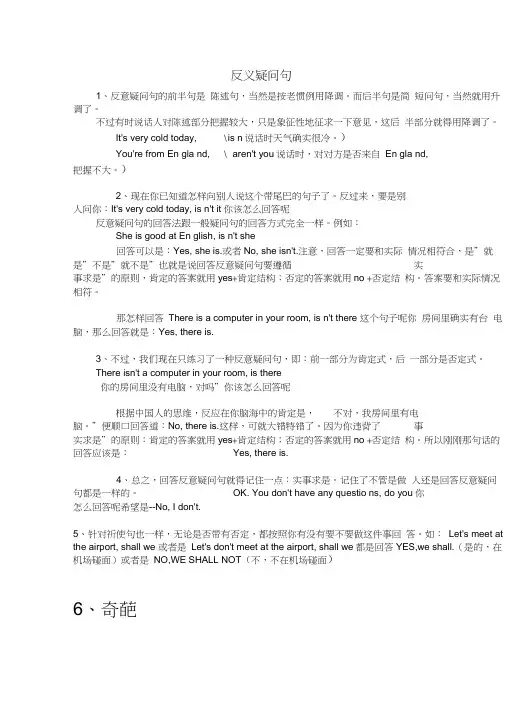
反义疑问句1、反意疑问句的前半句是陈述句,当然是按老惯例用降调。
而后半句是简短问句,当然就用升调了。
不过有时说话人对陈述部分把握较大,只是象征性地征求一下意见,这后半部分就得用降调了。
It's very cold today, \is n说话时天气确实很冷。
)You're from En gla nd, \ aren't you说话时,对对方是否来自En gla nd,把握不大。
)2、现在你已知道怎样向别人说这个带尾巴的句子了。
反过来,要是别人问你:It's very cold today, is n't it你该怎么回答呢反意疑问句的回答法跟一般疑问句的回答方式完全一样。
例如:She is good at En glish, is n't she回答可以是:Yes, she is.或者No, she isn't.注意,回答一定要和实际情况相符合,是”就是”不是”就不是”也就是说回答反意疑问句要遵循实事求是”的原则,肯定的答案就用yes+肯定结构;否定的答案就用no +否定结构。
答案要和实际情况相符。
那怎样回答There is a computer in your room, is n't there 这个句子呢你房间里确实有台电脑,那么回答就是:Yes, there is.3、不过,我们现在只练习了一种反意疑问句,即:前一部分为肯定式,后一部分是否定式。
There isn't a computer in your room, is there你的房间里没有电脑,对吗”你该怎么回答呢根据中国人的思维,反应在你脑海中的肯定是,不对,我房间里有电脑。
”便顺口回答道:No, there is.这样,可就大错特错了。
因为你违背了事实求是”的原则:肯定的答案就用yes+肯定结构;否定的答案就用no +否定结构。
所以刚刚那句话的回答应该是:Yes, there is.4、总之,回答反意疑问句就得记住一点:实事求是。
反义疑问句讲解及答案
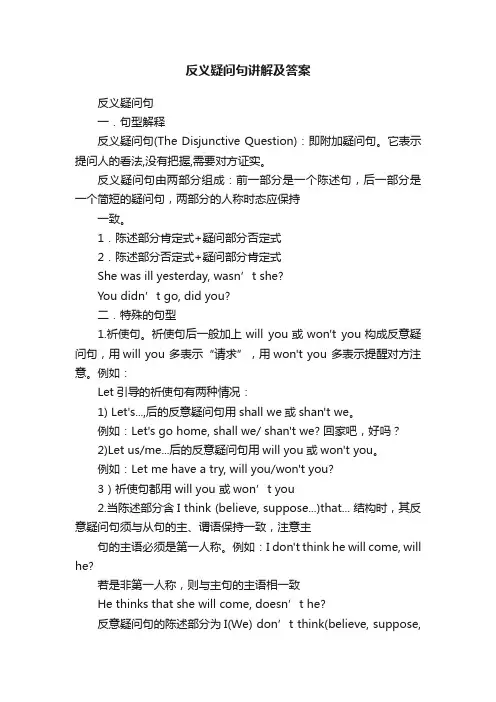
反义疑问句讲解及答案反义疑问句一.句型解释反义疑问句(The Disjunctive Question):即附加疑问句。
它表示提问人的看法,没有把握,需要对方证实。
反义疑问句由两部分组成:前一部分是一个陈述句,后一部分是一个简短的疑问句,两部分的人称时态应保持一致。
1.陈述部分肯定式+疑问部分否定式2.陈述部分否定式+疑问部分肯定式She was ill yesterday, wasn’t she?You didn’t go, did you?二.特殊的句型1.祈使句。
祈使句后一般加上will you或won't you构成反意疑问句,用will you 多表示“请求”,用won't you 多表示提醒对方注意。
例如:Let引导的祈使句有两种情况:1) Let's...,后的反意疑问句用shall we或shan't we。
例如:Let's go home, shall we/ shan't we? 回家吧,好吗?2)Let us/me...后的反意疑问句用will you或won't you。
例如:Let me have a try, will you/won't you?3)祈使句都用will you 或won’t you2.当陈述部分含I think (believe, suppose...)that... 结构时,其反意疑问句须与从句的主、谓语保持一致,注意主句的主语必须是第一人称。
例如:I don't think he will come, will he?若是非第一人称,则与主句的主语相一致He thinks that she will come, doesn’t he?反意疑问句的陈述部分为I(We) don’t think(believe, suppose,consider)+ that从句时,从句为否定意义,问句部分的动词和主语仍与that从句保持一致且用肯定式。
反义疑问句讲解上课讲义
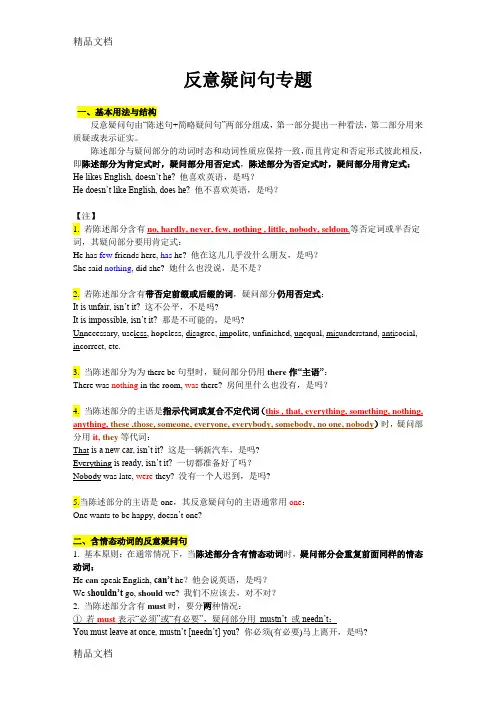
反意疑问句专题一、基本用法与结构反意疑问句由“陈述句+简略疑问句”两部分组成,第一部分提出一种看法,第二部分用来质疑或表示证实。
陈述部分与疑问部分的动词时态和动词性质应保持一致,而且肯定和否定形式彼此相反,即陈述部分为肯定式时,疑问部分用否定式,陈述部分为否定式时,疑问部分用肯定式:He likes English, doesn’t he? 他喜欢英语,是吗?He doesn’t like English, does he? 他不喜欢英语,是吗?【注】1. 若陈述部分含有no, hardly, never, few, nothing , little, nobody, seldom,等否定词或半否定词,其疑问部分要用肯定式:He has few friends here, has he? 他在这儿几乎没什么朋友,是吗?She said nothing, did she? 她什么也没说,是不是?2. 若陈述部分含有带否定前缀或后缀的词,疑问部分仍用否定式:It is unfair, isn’t it? 这不公平,不是吗?It is impossible, isn’t it? 那是不可能的,是吗?Unnecessary, useless, hopeless, disagree, impolite, unfinished, unequal, misunderstand, antisocial, incorrect, etc.3. 当陈述部分为为there be句型时,疑问部分仍用there作“主语”:There was nothing in the room, was there? 房间里什么也没有,是吗?4. 当陈述部分的主语是指示代词或复合不定代词(this , that, everything, something, nothing, anything, these ,those, someone, everyone, everybody, somebody, no one, nobody)时,疑问部分用it, they等代词:That is a new car, isn’t it? 这是一辆新汽车,是吗?Everything is ready, isn’t it? 一切都准备好了吗?Nobody was late, were they? 没有一个人迟到,是吗?5.当陈述部分的主语是one,其反意疑问句的主语通常用one:One wants to be happy, doesn’t one?二、含情态动词的反意疑问句1. 基本原则:在通常情况下,当陈述部分含有情态动词时,疑问部分会重复前面同样的情态动词:He can speak English, can’t he?他会说英语,是吗?We shouldn’t go, should we? 我们不应该去,对不对?2. 当陈述部分含有must时,要分两种情况:①若must表示“必须”或“有必要”,疑问部分用mustn’t 或needn’t:You must leave at once, mustn’t [needn’t] you? 你必须(有必要)马上离开,是吗?但是若陈述部分有mustn’t表示禁止,疑问部分要must:You mustn’t laugh, must you? 你不准笑,知道吗?②若must表示推测,疑问部分不能用must,而应根据must后的动词结构采用相应的动词形式:He must be tired,isn’t he? 他一定累了,是吗?The ground is wet. It must have rained yesterday, didn’t it?三、陈述部分为祈使句的反意疑问句1. 基本原则:若陈述部分为祈使句,疑问部分通常用will you:Please help us, wil l you? 请帮帮我们,好吗?Come with us, will you? 同我们一起去,好吗?Don’t forget to post the letter, will you? 请别忘了寄信。
反义疑问句知识点详解(初中英语专项复习)3
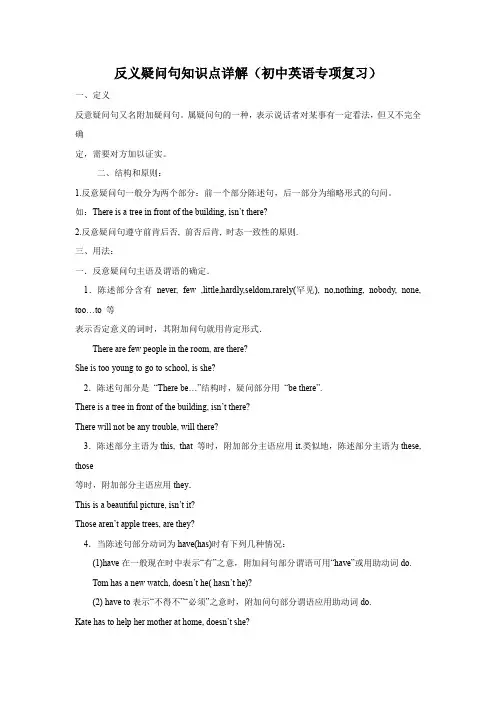
反义疑问句知识点详解(初中英语专项复习)一、定义反意疑问句又名附加疑问句。
属疑问句的一种,表示说话者对某事有一定看法,但又不完全确定,需要对方加以证实。
二、结构和原则:1.反意疑问句一般分为两个部分:前一个部分陈述句,后一部分为缩略形式的句问。
如:There is a tree in front of the building, isn’t there?2.反意疑问句遵守前肯后否, 前否后肯, 时态一致性的原则.三、用法:一.反意疑问句主语及谓语的确定.1.陈述部分含有never, few ,little,hardly,seldom,rarely(罕见), no,nothing, nobody, none, too…to 等表示否定意义的词时,其附加问句就用肯定形式.There are few people in the room, are there?She is too young to go to school, is she?2.陈述句部分是“There be…”结构时,疑问部分用“be there”.There is a tree in front of the building, isn’t there?There will not be any trouble, will there?3.陈述部分主语为this, that 等时,附加部分主语应用it.类似地,陈述部分主语为these, those等时,附加部分主语应用they.This is a beautiful picture, isn’t it?Those aren’t apple trees, are they?4.当陈述句部分动词为have(has)时有下列几种情况:(1)have在一般现在时中表示“有”之意,附加问句部分谓语可用“have”或用助动词do.Tom has a new watch, doesn’t he( hasn’t he)?(2) have to表示“不得不”“必须”之意时,附加问句部分谓语应用助动词do.Kate has to help her mother at home, doesn’t she?(3) have 表示“吃、喝、玩、度过”等意时,其附加问句的谓语应用助动词do.They have a good time in Beijing, don’t they?(4)have 在完成时中,其附加问句谓语动词应用have.Lucy has ever been to Japan, hasn’t she?(5) had better 最好,在祈使句中,其附加问句谓语动词应用hadYou had better clean the room,hadn’t you?5.肯定的祈使句的附加问句可用will you或won’t you,否定的祈使句的附加问句用will you.Listen to me carefully, will you?Don’t play with fire, will you?6.以let’s开头的祈使句,附加问句用shall we;而以let us 开头的祈使句,附加问句用will you.Let’s go to the park, shall we?Let us help you, will you?7.think, believe, expect, imagine, suppose等引导的宾语从句:A.主语是第一人称(应特别注意否定的转移)I don’t think he is bright, is he?We believe she can do it better, can’t she?B. 如果主语不是第一人称则疑问部分与主句相对应构成反意疑问句He thought they were wrong, didn’t he?8.否定前缀或后缀(否定前缀dis-, un-, im-或否定后缀-less,如dislike, discourage, unfair, unable等)不能视为否定词,其反意疑问句仍用否定形式。
初中英语反意疑问句专项语法讲解
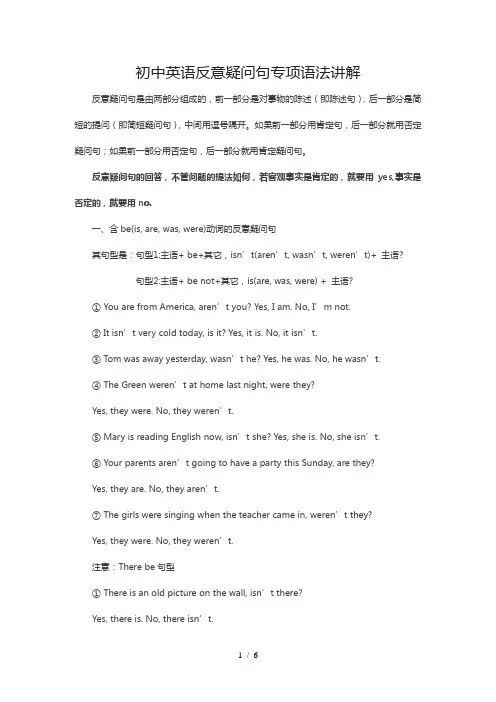
初中英语反意疑问句专项语法讲解反意疑问句是由两部分组成的,前一部分是对事物的陈述(即陈述句),后一部分是简短的提问(即简短疑问句),中间用逗号隔开。
如果前一部分用肯定句,后一部分就用否定疑问句;如果前一部分用否定句,后一部分就用肯定疑问句。
反意疑问句的回答,不管问题的提法如何,若客观事实是肯定的,就要用yes,事实是否定的,就要用no.一、含be(is, are, was, were)动词的反意疑问句其句型是:句型1:主语+ be+其它,isn’t(aren’t, wasn’t, weren’t)+ 主语?句型2:主语+ be not+其它,is(are, was, were) + 主语?① You are from America, aren’t you? Yes, I am. No, I’m not.② It isn’t very cold today, is it? Yes, it is. No, it isn’t.③ Tom was away yesterday, wasn’t he? Yes, he was. No, he wasn’t.④ The Green weren’t at home last night, were they?Yes, they were. No, they weren’t.⑤ Mary is reading English now, isn’t she? Yes, she is. No, she isn’t.⑥ Your parents aren’t going to have a party this Sunday, are they?Yes, they are. No, they aren’t.⑦ The girls were singing when the teacher came in, weren’t they?Yes, they were. No, they weren’t.注意:There be句型① There is an old picture on the wall, isn’t there?Yes, there is. No, there isn’t.②There aren’t any children in the room, are there?Yes, there are. No, there aren’t.③ There wasn’t a telephone call for me, was there?Yes, there was. No, there wasn’t.④ There were enough people to pick apples, weren’t there?Yes, there wer e. No there weren’t.二、行为动词的一般现在时的反意疑问句其句型是:句型1: 主语+动词原形+其它,don’t I(you, we, they)?句型2: 主语+ don’t+动词原形+其它,do I(you, we, they)?句型3: 主语+动词第三人称单数+其它,doesn’t he(she, it)?句型4: 主语+ doesn’t+动词原形+其它,does he(she, it)?① You often watch TV in the evening, don’t you? Yes, I do. No, I don’t.② The students don’t study hard, do they? Yes, they do. No, they don’t.③ Mary studies Chinese hard, doesn’t she? Yes, she does. No, she doesn’t.④ The boy doesn’t often go to school b y bike, does he?Yes, he does. No, he doesn’t.⑤ The first class begins at eight, doesn’t it? Yes, it does. No, it doesn’t.三、行为动词的一般过去时的反意疑问句其句型是:句型1: 主语+动词过去式+其它,didn’t+主语?句型2: 主语+didn’t+动词原形+其它,did +主语?① You watched TV last night, didn’t you? Yes, I did. No, I didn’t.② Jim’s parents didn’t go to Hong Kong last month, did they?Yes, they did. No, they didn’t.③ The rain stopped, didn’t it? Yes, it did. No, it didn’t.④ Mr. Clarke didn’t buy a car, didn’t he? Yes, he did. No, he didn’t.四、一般将来时的反意疑问句其句型是:句型1: 主语+will+动词原形+其它,won’t+主语?句型2: 主语+ won’t +动词原形+其它,will +主语?① The boys will play games, won’t they? Yes, they will. No, they won’t.② It won’t stop raining, will it? Yes, it will.No, it won’t.③ Mr. Smith will visit our school next week, won’t he? Yes, he will. No, he won’t.注意:There be句型的一般将来时① There will be a basketball match tomorrow, won’t there?Yes, there will. No, there won’t.② There won’t be too much pol lution in the future, will there?Yes, there will. No, there won’t.五、现在完成时的反意疑问句其句型是:句型1: 主语+have+动词过去分词+其它,haven’t+主语?句型2: 主语+ haven’t +动词过去分词+其它,have +主语?句型3: 主语+has+动词过去分词+其它,hasn’t+主语?句型4: 主语+ has n’t +动词过去分词+其它,has +主语?① You have been to Shanghai before, haven’t you? Yes I have. No, I haven’t.② You haven’t been to Shanghai before, have you? Yes I have. No, I haven’t.③ Jack has done his homework, hasn’t he? Yes, he has. No, he hasn’t.④ Jack hasn’t done his homework, has he? Yes, he has. No, he hasn’t.六、现在完成进行时的反意疑问句其句型是:句型1: 主语+have been+动词现在分词+其它,haven’t+主语?句型2: 主语+ haven’t been +动词现在分词+其它,have +主语?句型3: 主语+has been +动词现在分词+其它,hasn’t+主语?句型4: 主语+ hasn’t been +动词现在分词+其它,has +主语?① You have been skating for five hours, haven’t you? Yes, I have. No, I haven’t.② You haven’t been skating for five hours, have you? Yes, I have. No, I haven’t.③ Bob has been collecting kites since 1999, hasn’t h e? Yes, he has. No, he hasn’t.④ Bob hasn’t been collecting kites since 1999, has he? Yes, he has. No, he hasn’t.七、含有情态动词的反意疑问句其句型是:句型1: 主语+情态动词+动词原形+其它,情态动词否定形式+主语?句型2: 主语+情态动词否定形式+动词原形+其它,情态动词+主语?① You can speak French, can’t you?Yes, I can. No, I can’t.② They can’t understand me, can they? Yes, they can. No, they can’t.③ Ann could swim when she was six, couldn’t she? Yes, she could. No, she couldn’t.④ The students must study hard, mustn’t they? Yes, they must. No, they needn’t.注意:You must go home now, needn’t you? Yes, I must. No, I needn’t.★ 值得注意的是有时英语的谓语动词并不用否定式(即没加上not),而是用上了“never, little, few, hardly, nothing, nobody”等词,这时该陈述句也属于否定句,因此,反意疑问句的后半部分应用肯定疑问式。
(完整版)反义疑问句详细讲解及习题及答案
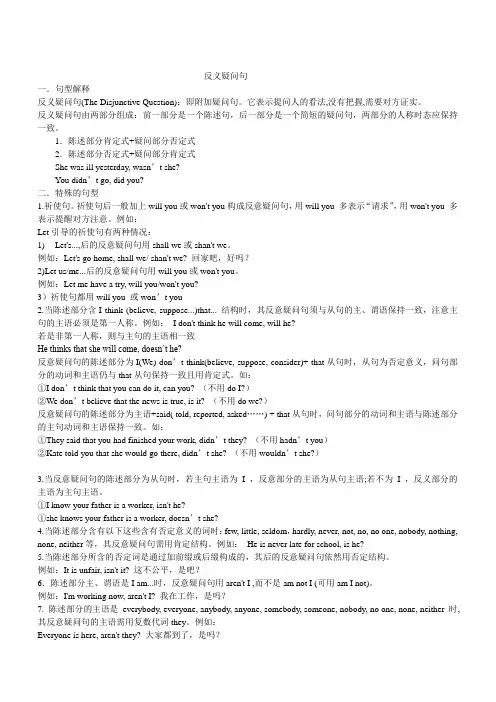
反义疑问句一.句型解释反义疑问句(The Disjunctive Question):即附加疑问句。
它表示提问人的看法,没有把握,需要对方证实。
反义疑问句由两部分组成:前一部分是一个陈述句,后一部分是一个简短的疑问句,两部分的人称时态应保持一致。
1.陈述部分肯定式+疑问部分否定式2.陈述部分否定式+疑问部分肯定式She was ill yesterday, wasn’t she?You didn’t go, did you?二.特殊的句型1.祈使句。
祈使句后一般加上will you或won't you构成反意疑问句,用will you 多表示“请求”,用won't you 多表示提醒对方注意。
例如:Let引导的祈使句有两种情况:1) Let's...,后的反意疑问句用shall we或shan't we。
例如:Let's go home, shall we/ shan't we? 回家吧,好吗?2)Let us/me...后的反意疑问句用will you或won't you。
例如:Let me have a try, will you/won't you?3)祈使句都用will you 或won’t you2.当陈述部分含I think (believe, suppose...)that... 结构时,其反意疑问句须与从句的主、谓语保持一致,注意主句的主语必须是第一人称。
例如:I don't think he will come, will he?若是非第一人称,则与主句的主语相一致He thinks that she will come, doesn’t he?反意疑问句的陈述部分为I(We) don’t think(believe, suppose, consider)+ that从句时,从句为否定意义,问句部分的动词和主语仍与that从句保持一致且用肯定式。
中考英语反义问句专题精讲
反意疑问句定义:反意疑问句又叫附加疑问句(tag question)在陈述句之后,附加上一个简短句,对陈述句所叙述的事情提出的事情提出相反的疑问,这种疑问句叫反意疑问句。
构成:反意疑问句由两部分组成,前一部分是对是对事物的陈述,后一部分是针对所提出是事提出疑问。
如果前一部分用肯定式,后一部分就用否定式;如果前一部分用否定式,后一部分就用肯定式。
反意疑问句对应规则二十四条:一、反意疑问句中问句部分的动词与陈述部分的动词在语气上成相反的对应关系,即:肯定+否定?; 否定+肯定?如:① You can't do it, can you?② They are very late for the meeting, aren't they?二、反意疑问句中问句部分的动词与陈述部分的动词种类要对应一致。
如:① He has supper at home every day, doesn't he? (不能用hasn't he?)② They have known the matter, haven't they? (不能用don't they?)三、反意疑问句中问句部分的动词在时态上应和陈述部分的时态一致。
如:① They will go to town soon, won't they?(不能用don't they?或aren't they?)② He works very hard, doesn't he?(不能用didn't he?或won't he?)四、反意疑问句的陈述部分含有由un-, im-, in-, dis-, 等否定意义的前缀构成的词语时,陈述部分要视为肯定含义,问句部分用否定形式。
如:① Your father is unhappy, isn't he?(不能用is he?)② The man is dishonest, isn't he? (不能用is he?)③ It is impossible to learn English without remembering more words, isn't it?(不能用is it ?)五、反意疑问句的陈述部分带有little, few, never, hardly, seldom等否定意义的词时,问句部分用肯定式。
反义疑问句超详细讲解!!!
反义疑问句超详细讲解反义疑问句⼀、基本要点1、概念。
反义疑问句是疑问句的⼀种,它对陈述部分的事实提出相反的疑问,形式上是⼀个省略问句,附加在陈述句后通常译为“是吗?”形式:主句(陈述句),从句(问句)?You are from America, aren’t you?2、回答。
情况属实:Yes, I am/情况不属实:No, I’m not3、从句动词与主句动词在语⽓上是相反的关系,即:“前肯后否,前否后肯”①You can’t do it, can you?②They are very late for the meeting, aren’t they?【注意】:主句带有little, few, never, hardly, seldom,nobody, nothing, barely, scarcely等否定意义的词时,从句⽤肯定式。
①She never tells a lie, does she? ②He was seldom late, was he?⼆、⼀般构成法1、当主句含有be动词,助动词,或情态动词时,从句由这些词+主语⼈称代词构成。
be动词:am, is, are, was, were助动词:do, does, did, have, has等情态动词:can, could, may, might, must, will, would, shall, shouldShe is a lovely girl, isn’t she?He will go home, won’t he?She doesn’t like to eat apple, does she?The baby won’t sleep early, will it?【注意】:前后主语要相同。
2、当主句只有实义动词(⾏为动词)时,从句⽤do的适当形式。
(若动词加了s,就⽤does, 若动词为原形,就⽤do,动词为过去式,则⽤did)。
反义疑问句(最全)知识讲解
四、有情态动词的反义疑问句:
1.带情态动词dare或need的反意疑问句,疑问部分常 用 need (dare ) +主语。 We need not do it again, need we ? He dare not say so, dare he? 当dare, need 为实义动词时,疑问部分用助动词do + 主语。
D.must表示推测 ,其疑问部分必须与must 后面的主要 动词相呼应 ①对现在动作或存在的情况的推测(don’t +主语) You must know the answer to the exercise, don’t you? ②对过去发生的动作或存在的情况的推测有两种情况:
a 表示肯定推测 (一)句中陈述部分没有表示过去的时间状语,这时疑问 部分中的动词就用现在完成时。 (haven’t / hasn’t + 主语) You must have told her about it, haven’t you?
5.陈述部分有would rather +v.,疑问部分多用 wouldn’t +主语。 He would rather read it ten times than recite it,
wouldn’t he? 6.陈述部分有you’d like to +v. 疑问部分用wouldn’t + 主语。
三、一些特殊结构的反义疑问句:
1.含有ought to 的反意疑问句,陈述部分是肯定的,疑 问部分用shouldn’t / oughtn’t +主语。 He ought to know what to do, oughtn’t he? / shouldn’t he? 2.陈述部分有have to +v. (had to + v.),疑问部分常用 don’t +主语(didn’t +主语)。 We have to get there at eight tomorrow, don’t we? 3.陈述部分的谓语是used to 时,疑问部分用didn’t +主 语或 usedn’t +主语。 He used to take pictures there, didn’t he? / usedn’t he? 4.陈述部分有had better + v. 疑问句部分用hadn’t you? You’d better read it by yourself, hadn’t you?
超好 反义疑问句专项讲解
反意疑问句变反意疑问句遵循的基本原则:前肯后否,前否后肯例如:She is a beautiful girl, isn’t she ?She isn’t a beautiful girl, is she ?反意疑问句疑问部分动词的选择:主要看陈述句部分变一般疑问句或否定句用哪一个词,疑问部分的动词就用哪一个词。
例如:He is a clever boy, isn’t he ?He can speak English, can’t he ?She gets up at seven every morning, doesn’t she ? (陈述句部分变一般疑问句或否定句用助动词“does”,所以反问部分也用“does”。
) They have finished their homework, have n’t they ?反意疑问句疑问部分主语的选择:同陈述句部分的主语一致。
(注:当陈述句部分的主语是人名时,疑问部分的主语用它相应的人称代词“he”“she”“they”形式。
当陈述句部分的主语是其它名词时,疑问部分的主语用它相应的“it”“they”代词形式。
其它特殊情况在下面要讲到)使用反意疑问句要注意以下若干对应规则:1、反意疑问句的陈述部分带有no (no one/none/nothing/nobody), not, little, few, never, hardly, seldom等否定意义的词时,问句部分用肯定式。
如:①She never tells a lie, does she?(不用doesn't she?)②He was seldom late, was he?(不用wasn't he?)2、反意疑问句的陈述部分含有由un-, im-, in-, dis-, 等否定意义的前缀构成的词语时,陈述部分要视为肯定含义,问句部分用否定形式。
如:①Your father is unhappy, isn't he?(不能用is he?)②The man is dishonest, isn't he? (不能用is he?)③It is impossible to learn English without remembering more words, isn't it?(不能用is it ?)3、反意疑问句的陈述部分为I am……时,问句部分习惯上用aren't I?表示。
- 1、下载文档前请自行甄别文档内容的完整性,平台不提供额外的编辑、内容补充、找答案等附加服务。
- 2、"仅部分预览"的文档,不可在线预览部分如存在完整性等问题,可反馈申请退款(可完整预览的文档不适用该条件!)。
- 3、如文档侵犯您的权益,请联系客服反馈,我们会尽快为您处理(人工客服工作时间:9:00-18:30)。
18、陈述部分有would rather + v.疑问部分 多用 wouldn't +主语。
2. 感叹句。感叹句后加反意疑问句时,其反意疑问 句需用be 的一般现在时态的否定形式。 例如:What fine weather, isn’t it ?多好的天气啊, 是吧? (What beautiful flowers, aren’t they ?) 3.陈述部分主、谓语是I am … 时,反意疑问句用 aren’t I。 例如:I am working now, aren’t I? 我在工作,是吗? 4.陈述部分的主语是everything ,nothing,anything 或 something时,反意疑问句的主语应用代词it 。 例如:Something is wrong with my radio, isn’t it ? 我的收音机出毛病了,是吗?
反义疑问句遵循前肯后否,前否 后肯的规则。即前面是肯定句, 后面就是否定句。前面是否定句, 后面就是肯定句。
下面让我们来看一些特殊的 反义疑问句
反意疑问句的用法
1. 祈使句。祈使句后一般加上will you 或 won’t you 构成反意疑问句,用will you 多表示 “请求”,用won’t you多表示提醒对方注意。例 如:Look at the blackboard , will you?看黑板,好吗? ( Don’t open the door, will you ?) Let 引导的祈使句有两种情况: a) Let’s … , 后的反意疑问句用shall we 或shan’t we。 例如:Let’s go home ,shall we ?回家吧,好吗?(还 可以用may I来表示征求对方的同意或许可。) b) Let us /me…后的反意疑问句用will you。例如: Let me have a try ,will you ?让我试一试,行吗?
TheTag Question
反义疑问句
(The Disjunctive Question)又 叫附加疑问句。它表示提问人的 看法,没有把握,需要对方证实。 反义疑问句由两部分组成:前一 部分是一个陈述句,后一部分是 一个简短的疑问句,两部分的人 称时态应保持一致。
基本模式: 1.陈述部分肯定式 + 疑问部分否定式
4) 如:作“想必”的意思时,附加部分根 据后面的部分结构来确定,不用mustn’t must be tired, aren’t you ? He must be at home, isn’t he ?
You
16、带情态动词dare或need的反意疑问句, 疑问部分常用 need (dare ) +主语。
. 24、 反义疑问句的回答用yes, no 但是,当陈述部分是否定形 式时,回答要按事实。 They don’t work hard, do they? Yes, they do.
不, 他们工作努力。 No, they don’t. 对, 他们工作不努力。
• —We haven’t such a chance in a million. • 我们没有这样千载难逢的机会。 • —Oh, we haven’t such a chance in a million, haven’t we? • 怎么,我们没有这样的机会? • So he likes the idea, does he? • 那他赞成这个想法,是吧? • So she thinks she’s going to become a doctor, does she? Well, well. • 那她想要当个医生,是吗? 那好,那好。
15. 当陈述部分含有情态动词must时,我 们最好分析一下must的含义。如果must 作“一定;要;必须”讲,反意疑问句须 用mustn’t或needn’t;而当must作推测 意义“一定是;必定”讲时,反意疑问句 则需根据must后的动词原形选相应的形式。
1) 如 must 表“有必要”时,附加部分用 needn’t.
• 22、表示讽刺或怀疑,多用于口语。 • —Tom told me he saw a ghost last night. • 汤姆告诉我,他昨天见到了鬼。 • —He did, did he? • 他见到了鬼,是吗?
23、表示兴趣、关心、惊奇或愤怒等 感情。在这种结构里,疑问部分有 时用right, eh, OK,等。 • So you’re going to leave us, eh? • 你就要离开我们了,嗯? • We’re old friends, not strangers, right? • 我们是老朋友,不是陌生人,对吧?
7.陈述部分的主语是不定代词one 时,反意疑问句 的主语可以用one,也可以用you (美式英语用he )。例 如: One should be ready to help others, shouldn’t one?每个人都应该乐于助人,是吧? 8.当陈述部分含有以下这些含有否定意义的词时: few, little, hardly, never, not , no, no one , nobody ,nothing ,none, neither等,其反意疑问句需 用肯定结构。 例如:He is never late for school , is he? 他上学从不 迟到,是吗? 9.当陈述部分所含的否定词是通过加前缀或后缀构 成的,其后的反意疑问句依然用否定结构。 例如:It is unfair, isn’t it ?这不公平,是吧?
5.陈述部分的主语是everybody, everyone, anybody, anyone, somebody, someone ,nobody, no one, none, neither 时,其反意疑问句的主语需用复数代词they 。 例如:Everyone is here ,aren’t they?大家都到了, 是吗? No one knows about it , do they ?没有人知道这件事, 对吗? 6.陈述部分的主语是指示代词this 或that 时,反意 疑问句的主语用it , 当陈述部分的主语是指示代词 these 或those时,其反意疑问句的主语用they 。例 如: This is a plane, isn’t it ?这是一架飞机,是吗? These are grapes, aren’t they? 这些是葡萄,是吗?
You must go home right now, needn’t you ?
2) 如must表“禁止”时,附加部分用 mustn’t
You mustn’t walk on grass, must you ?
3) 如must have done 的结构,前句强调对 过去情况的猜测时(一般有过去时间状语) 附加部分用 didn’t + 主语。如果前句强调 动 作 的 完 成 , 附 加 部 分 则 用 haven’t (hasn’t ) + 主语。 He must have met her yesterday, didn’t he ? You must have been to Beijing, haven’t you ?
20、陈述部分由neither… nor, either… or 连接的并列主语时, 疑问部分根据其实际逻辑意义 而定。 Neither you nor I am engineer, are we?
Either you or he is
isn ’ t he right,_____?
21、
当陈述部分的动词用have
12. 陈述部分有have to 时,其反意疑问句要 用助动词的否定形式。 例如: You have to water the vegetables every day, don’t you ?你每天都要浇菜,对吧? 13. 陈述部分是there be 句型时,其反意疑问 句中要用there . 例如:There was a hospital here, wasn’t there ?过去这儿有家医院,是吗? 14. 陈述部分有had better 时,其反意疑问句 要用hadn’t . 例如We had better go to school at once , hadn’t we ?我们现在最好马上上学,好吗?
1) “吃饭,上课,开会”作谓语时,附加 部分用do 的形式。 he He has four classes every doesn't morning, ? don't you You have only milk for breakfast, ? 2 ) 表 “拥有”, 反问句谓语用 have 或 do . He has a foreign friend, doesn't he ? You have a new dictionary, haven't you ?
They work here, don’t they?
She was ill yesterday, wasn’t she? 2.陈述部分 did you?
He can’t ride a bike, can he?
Let’s have a summary
10.当陈述部分主语是从句、不定式(短语)、动 词-ing 形式时,反意疑问句的主语应该用it 。例如: What you need is more importment , isn’t it ? 你需 要的东西更重要,是吧? 11.当陈述部分含I think (believe ,suppose…)that… 结构时,其反意疑问句须与从句的主、谓语保持一 致,注意主句的主语必须是第一人称. 例如:I don’t think he will come ,will he ? 我认为他不会来,对吗? (依从句,看整体) He doesn’t think she will come , does he ? 他认为她不会来,对吗? (依主句,看整体)
